Coastal geomorphology is a branch of geology that focuses on the landforms and processes shaping the coastlines of the world. From sandy beaches to rocky cliffs, coastal landscapes are constantly changing due to the forces of nature.
Understanding Coastal Processes
Coastal geomorphologists study the various processes that shape coastal environments, such as erosion, deposition, and weathering. By analyzing these processes, researchers can better predict how coastlines will change over time and develop strategies to manage coastal hazards.
The Power of Waves
Waves are one of the most significant forces shaping coastal landforms. The energy of waves can erode cliffs, carve out sea caves, and deposit sediments along the shoreline. By studying wave patterns and strengths, scientists can predict how coastlines will evolve in response to changing sea levels and climate conditions.
The Role of Tides
Tides also play a critical role in coastal geomorphology. The rise and fall of tides can erode cliffs, shape beaches, and create tidal channels. By studying tidal patterns and the interactions between tides and waves, researchers can uncover the mysteries of coastal landscapes and how they are influenced by astronomical forces.
Human Impacts on Coastal Geomorphology
Human activities, such as coastal development and pollution, can also impact coastal geomorphology. By altering natural processes, such as sediment transport and erosion, humans can accelerate coastal erosion and disrupt delicate coastal ecosystems. Understanding these impacts is essential for developing sustainable coastal management practices.
Protecting Coastal Environments
By studying the mysteries of coastal geomorphology, researchers can develop strategies to protect and conserve coastal landscapes. From building seawalls to restoring wetlands, there are various ways to mitigate the impacts of coastal erosion and preserve the unique beauty of coastal environments for future generations.
In conclusion, uncovering the mysteries of coastal geomorphology is essential for understanding how coastlines are shaped and how they will continue to evolve in the future. By studying the forces of waves, tides, and human impacts, scientists can develop strategies to protect and preserve these dynamic landscapes for generations to come.

